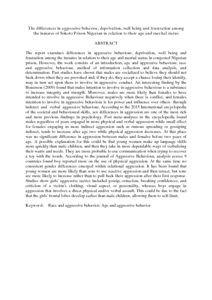Citation
Yusuf, Ibrahim and Ma’aruf, Redzuan and Hamsan, Hanina Halimatussadiah and Ahmad, Nobaya
(2016)
The differences in aggressive behavior, deprivation, well being and frustration among the inmates of Sokoto Prison Nigerian in relation to their age and marital status.
IOSR Journal of Humanities and Social Science, 21 (8).
pp. 13-26.
ISSN 2279-0845; ESSN: 2279-0837
Abstract
The report examines differences in aggressive behaviour, deprivation, well being and frustration among the inmates in relation to their age and marital status in congested Nigerian prison.However,the work consists of an introduction, age and aggressive behaviour, race and aggressive behaviour, method of information collection and data analysis, and determination. Past studies have shown that males are socialized to believe they should not back down when they are provoked and, if they do, they accept a chance losing their identity, may in turn act upon them to involve in aggressive conduct. An interesting finding by the Benenson (2009) found that males intention to involve in aggressive behaviour is a substance to increase integrity and strength. Moreover, males are more likely than females to have intended to involve in aggressive
behaviour negatively when there is conflict, and females intention to involve in aggressive behaviour is for power and influence over others through indirect and verbal aggressive behaviour. According to the 2015 International encyclopedia of the societal and behavioural skills, sex differences in aggression are one of the most rich and most previous findings in psychology. Post meta-analyses in the encyclopedia found males regardless of years engaged in
more physical and verbal aggression while small effect for females engaging in more indirect aggression such as rumour spreading or gossiping indirect, tends to increase after age two while physical aggression decreases.At that place was no significant difference in aggression between males and females before two years of age.A possible explanation for this could be that young women make up language skills more quickly than male children, and then they take in more dependable ways of verbalizing their wants and needs.They are more probable to use communication when trying to recover a toy with the words. According to the journal of
Aggressive Behaviour, analysis across 9 countries found boy reported more on the use of physical aggression.
At the same time no consistent gender differences emerged within relational aggression. It has been found that
young women are more likely than sons to use reactive aggression and then retract, but sons are more likely to
increase rather than to pull back their aggression after their first response.Studies show girls' aggressive tactics
included gossip, ostracism, breaking confidences, and criticism of a victim's clothing, visual aspect, or
personality, whereas boys engage in aggression that involves a direct physical and/or verbal assault.This could be due to the fact that the girls' frontal lobes develop earlier than male children, allowing them to self-limit.
Download File
![[img]](http://psasir.upm.edu.my/52967/1.hassmallThumbnailVersion/The%20differences%20in%20aggressive%20behavior%2C%20deprivation%2C%20well%20being%20and%20frustration%20among%20the%20inmates%20of%20Sokoto%20Prison%20Nigerian%20in%20relation%20to%20their%20age%20and%20marital%20status.pdf)  Preview |
|
PDF (Abstract)
The differences in aggressive behavior, deprivation, well being and frustration among the inmates of Sokoto Prison Nigerian in relation to their age and marital status.pdf
Download (7kB)
| Preview
|
|
Additional Metadata
Actions (login required)
 |
View Item |

